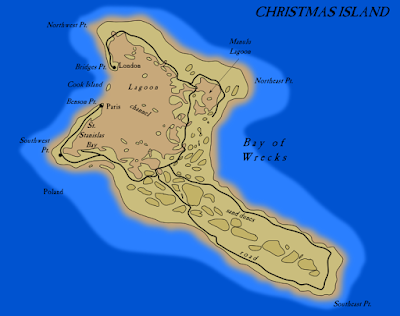It is Christmas and Its been a busy time so please enjoy these maps of Christmas Island (aka Kiritimati)
Or, if you prefer the Christmas Island in the Indian Ocean.
 |
| Via Enderra |
 |
| Via Enderra |
I did not take the time to participate but was amazed at the people who did, many of them every day-and some of the results are pretty fantastic. I will highlight some of the ones I liked (mostly showing the tweets) though I did not see everything that came along.Announcing #30DayMapChallenge in November 2019! Create a map each day of the month with the following themes 🌍🌎🌏— Topi Tjukanov (@tjukanov) October 25, 2019
No restriction on tools. All maps should be created by you. Doing less than 30 maps is fine. #gischat #geography #cartography #dataviz pic.twitter.com/6Go4VFWcJB
Mangroves vs HurricanesDía 28: Divertido / #Yïkxekp— Colmix (@Colmixe) November 29, 2019
Un mapa de las #naciones de #Oaxaca en estilo #Lego#30daymapchallenge pic.twitter.com/atCYy1lWrQ
European Hydrology#30DayMapChallenge Day 25: Climate - Mangroves vs Hurricanes— Christopher Pollard (@CRVanPollard) November 25, 2019
Mangroves have the ability to lessen the impact of flooding caused by hurricanes (reducing storm surges by 26-76%) BUT they are in an annual decline globally. pic.twitter.com/zH2nsElrFS
More from Maarten Lambrechts here.#30DayMapChallenge nr 26 (hydrology): Where each drop of rain in Europe (EU, actually) flows to pic.twitter.com/8iJ9krRRtE— Maarten Lambrechts (@maartenzam) November 26, 2019
Commuter Rail in the Northeasten USA#30DayMapChallenge Day 4: Hexagons— Craig Taylor (@CraigTaylorGIS) November 4, 2019
Citibike trip data binned into hex pillars by finish position and pivoted into hourly blocks by stop time for New York.
Data via: https://t.co/OFuEtfnixP#map #3d #dataviz #nyc pic.twitter.com/tAnVDy1s5r
London Fried Chicken TerritoriesMy submission for #30DayMapChallenge day 2 - lines:— Philip Pierdomenico (@PhilPierdo) November 2, 2019
Commuter rail (not Amtrak) in northeastern US. Some data was hard to find (esp @MTA). I've taken these lines from Wilmington DE to New Haven CT. Shows how challenging #railroad is in US. #Map produced in #QGIS 3.8. pic.twitter.com/HKgzCUYRr8
and whatever this is.London chicken territories, based on purveyors of fried chicken. #30DayMapChallenge #Day28 #Funny pic.twitter.com/DJZxBOqHrE— Heikki Vesanto (@HeikkiVesanto) November 28, 2019
— emil (@57x025) November 28, 2019For more here is a huge gallery of submissions.
Holy to Jews, Christians, and Muslims, modern Jerusalem has been shaped by 3,000 years of worship, conquest, devastation, and rebuilding. For @NatGeo, we worked on how to visualize this in a graphic. THREAD (1/21). https://t.co/qhwIBdAqNb pic.twitter.com/rhvl5y4AnJ— Alberto Lucas López (@aLucasLopez) November 26, 2019
One minor issue I have is the size comparison below. While most of us on the east coast of the United States understand this, I'm not sure how meaningful this is to people in other areas of the world.Using architectural plans, photographs and text descriptions that included building dimensions, we made detailed 3D models of buildings. Some of the architectural plans were pulled from the website https://t.co/uJJdjp5GEY. Others from the Library of Congress (@librarycongress). pic.twitter.com/xOeoYD6SEh— Alberto Lucas López (@aLucasLopez) November 26, 2019
 | |
| Via University of Chicago Press |
There is a lot to unpack in this map including many maps within the map. Here is a section detailing the railroad history of the Great Migration."Depicted here are some of the geographic, cultural and historical features of this area - the “Black Metropolis” of Chicago. In the period after the First World War, an African-American community of vitality and influence developed along these streets. The mixture of people here since the late 19th Century and those drawn here during the Great Migration of the 20th Century produced a new force in Black America: an urban home distinguished for its accomplishments in business, the arts and community life. Particularly notable was a flowering of great music - jazz, blues and gospel - that has enriched American culture from that time forward. Today the Bronzeville legacy lives on in a community that looks with pride to its past and with confidence to its future."

"This Japanese scroll stretches over twenty feet, detailing the coasts and landscapes, castles, shrines and towns. Japanese maps tended to be much larger than European maps of the same era. Many of them were designed to be laid out on wooden floor mats. Created for the purpose of tracking economic activity by region, it notes the annual taxes for each community. It also notes Nagasaki as the only port available to Dutch and Chinese traders. This hand drawn map was crafted in the traditional, pictorial style, known during this period as ezu; the mountains, rolling hills, villages, fortresses, temples, are highly stylized."The entire map can be browsed here. Here is a view of the entire map in one shot.